Front page of the Watauga Democrat, January 1, 1953. Via the nifty North Carolina Newspapers site.
Read this and other issues at https://www.digitalnc.org/newspapers/watauga-democrat-boone-n-c.
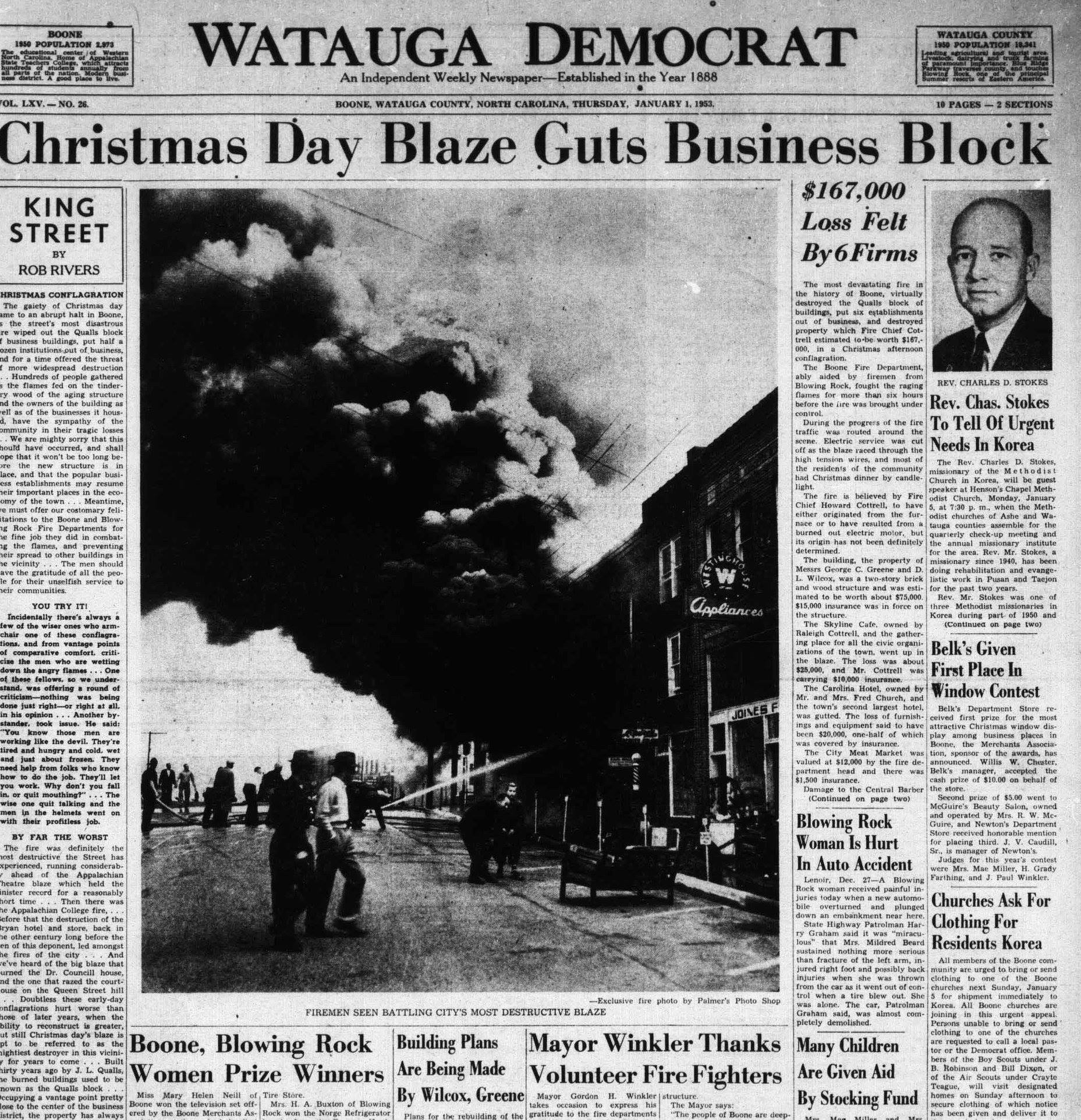
Front page of the Watauga Democrat, January 1, 1953. Via the nifty North Carolina Newspapers site.
Read this and other issues at https://www.digitalnc.org/newspapers/watauga-democrat-boone-n-c.

FYI, audio recordings from each Wake County Fire Commission meeting are now posted online, and just a couple days after each meeting[1]. They’re super-easy to find. Go to the official web page. Drill down under Minutes. And you’re there.
[1] These may have been available for a while now, on the web. Since Mr. Blogger’s usually there in person, he hasn’t needed the recorded version.
Back in the day, code words were used when requesting mutual aid from neighboring towns and cities. This was done to verify the authenticity of the requestor. The concept was first proposed at the 1950 conference of the North Carolina State Firemen’s Association. And enacted that year (I believe, need to check).
By the time of the 1953 conference, the code word was in-effect and members were asked by Statistician Albert Brinson (yes, related) to suggest a new word for next year. “Brock” was chosen, in memory of the great Sherwood Brockwell, the state’s first fire marshal (among many roles), and who passed away that year.
Recorded in the proceedings for the 1953 convention, President “Moon” Wyrick declared: “Whenever your Chief or whomever you designate, the Mayor, Board of Commissioners or Board of Aldermen, […] need mutual aid one among another, [they] will use the signal ‘BROCK’.”
Sources: Proceedings of the North Carolina State Firemen’s Association, 1950, 1953.
The North Carolina fire service is quite old, and goes all the way back the late 1700s. Artifacts from earlier eras are harder to come by, and anything pre-1900 is a bonafide find. Thus it’s a hysterical historical pleasure to share some early conference proceedings from the North Carolina State Firemen’s Association, from August 1896.
The 120-page document (see web directory, click 1896, beware large file size) is brimming with goodies, including stats on the member fire departments, tournament scores, vintage advertisements, and even a picture of Greensboro’s Eagle Hose Company’s “daughter”.
Scanned from the physical document, which is cataloged at Wilson Library at UNC-Chapel Hill. They have proceedings from various years between 1896 and 1957.
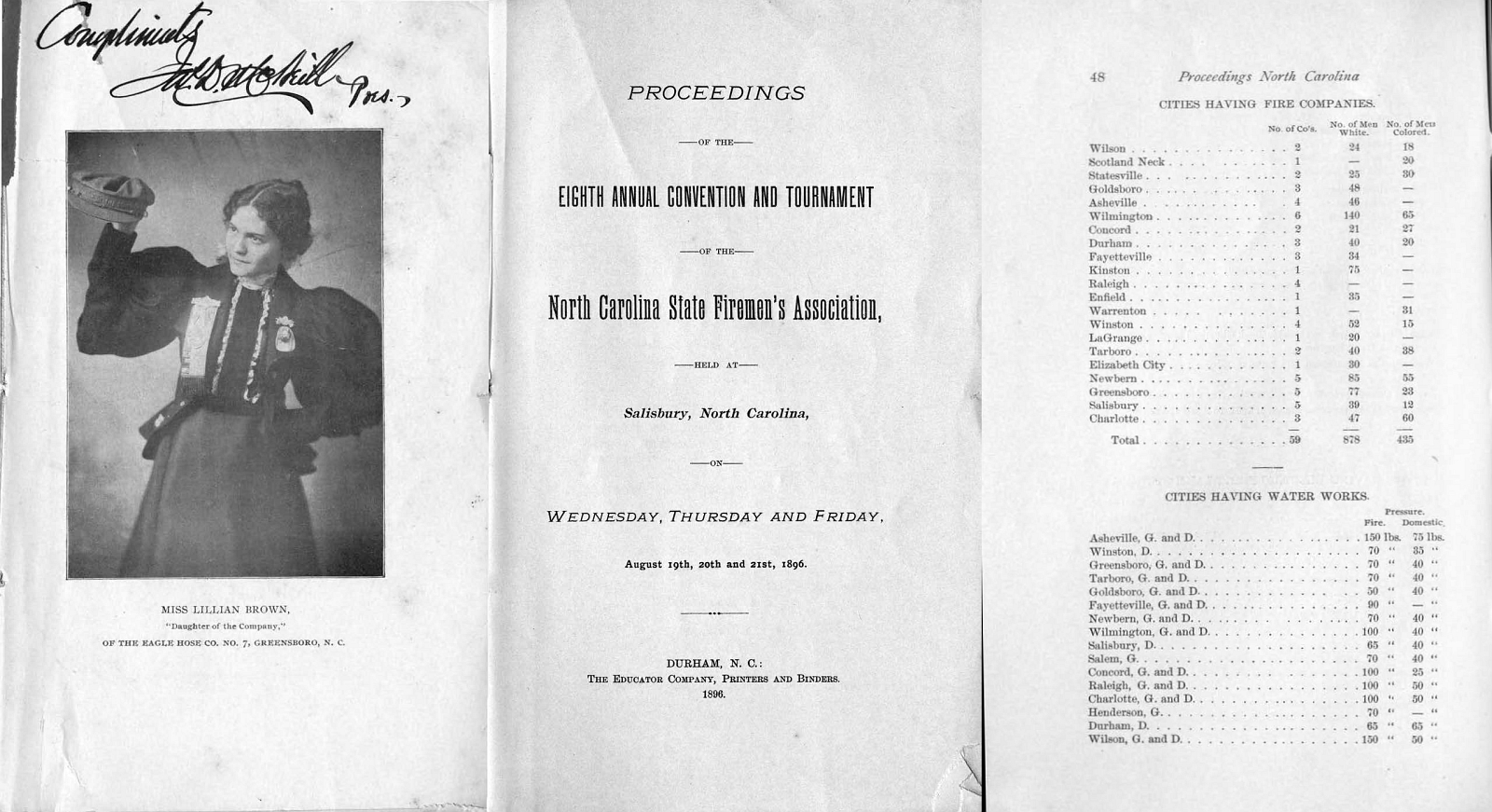
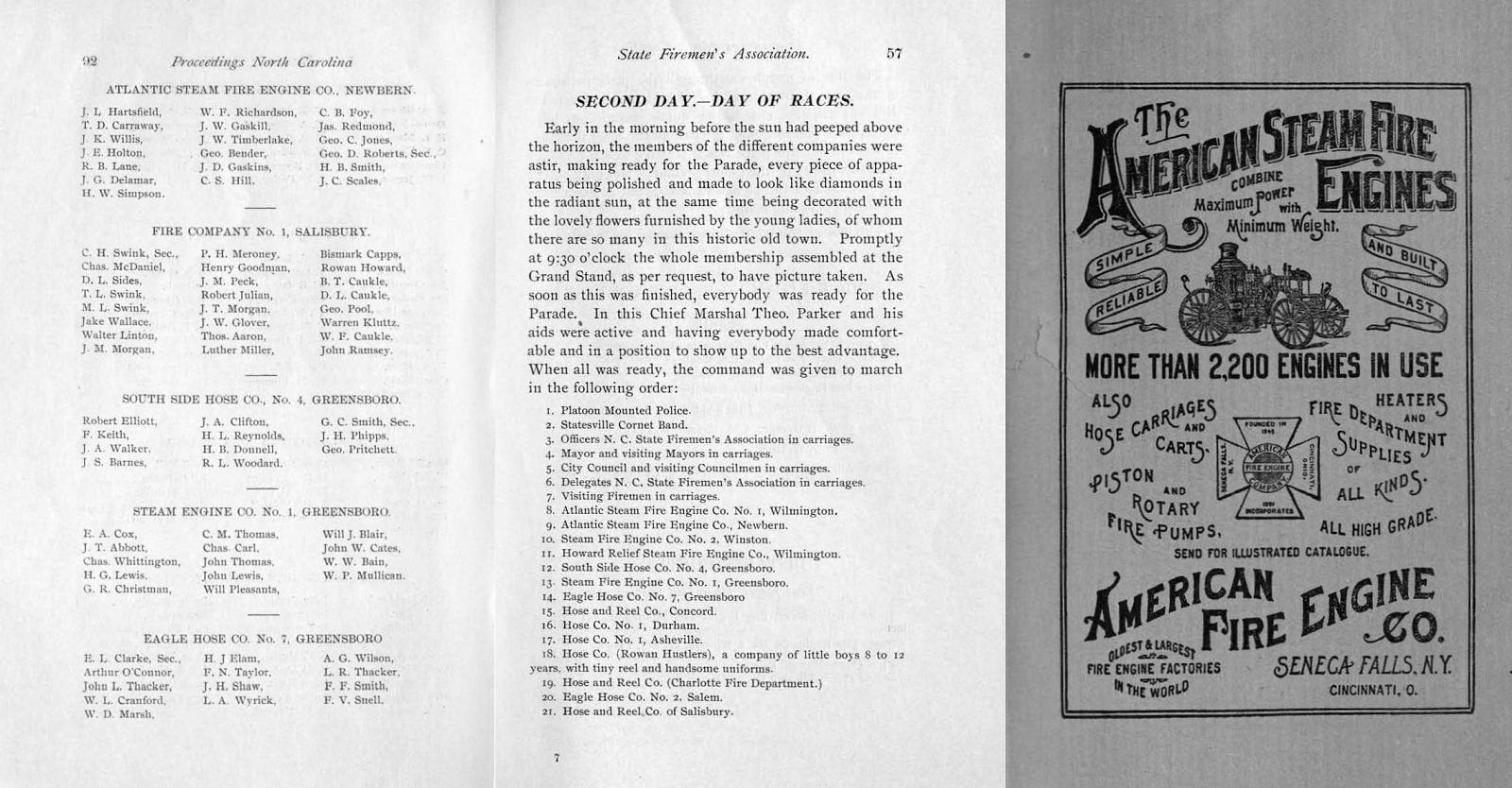
The Wake County Fire Commission met last night on Thursday, January 17, 2019. The meeting was held at the Wake County Emergency Services Education Center, 221 S. Rogers Lane, Raleigh.
Read the agenda packet, which includes correspondence to the Fire Services Director concerning the Fairview Station 2 closure concept, discussed in prior meetings. It was requested that those letters be included in the public record of meeting minutes.
Agenda
Meeting Called to Order: Chairman Keith McGee
Items of Business
Public Comments:
Regular Agenda
Information Agend
Other Business
Adjournment – Next Meeting March 21, 2019
January 18, 2019
Photos posted of the dedication ceremony:
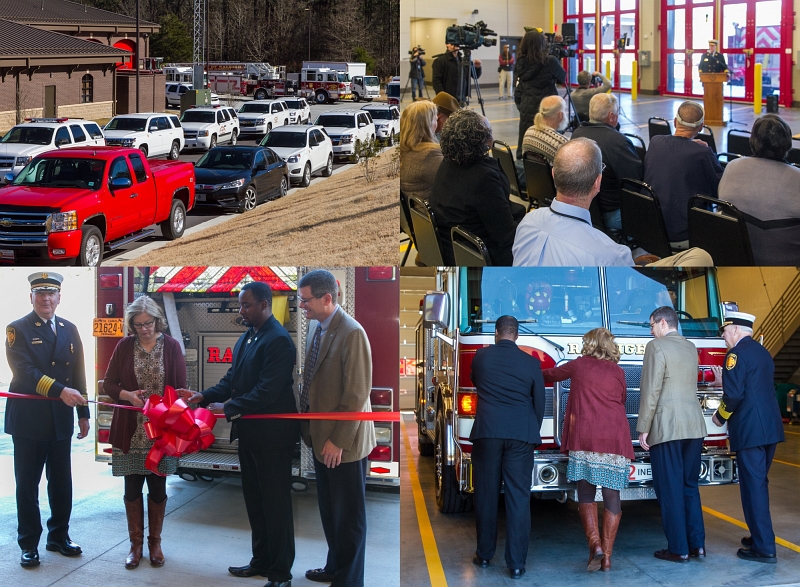
January 13, 2019
The City of Raleigh is dedicating new Fire Station 12 on Wednesday, January 16, at 1:00 p.m. It’s located at 4306 Poole Road, about a mile east of old Station 12. It’s also the largest of the city’s twenty-nine fire stations, with over 18,000 square feet. This dedication was original scheduled in September, but was postponed due to Hurricane Florence, and preparations for its impacts in Raleigh.
Here’s a brief press release.
See also Legeros photos of the new station, its construction, and the old station and its history.
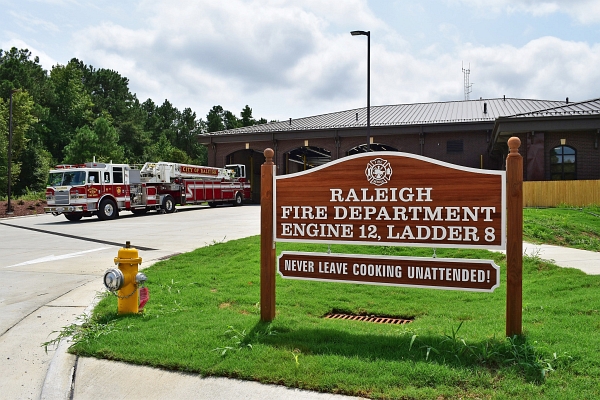
Lee Wilson photo
Continue reading ‘Relocating Fire Station 12 – Dedication on January 16’ »
Note: This is a version of a posting from Legeros Fire Line on Facebook. See that posting for reader comments and discussion.
Found a reference to a Tarboro Fire Department firefighter fatality, and apparently duty-related. From the Proceedings of the North Carolina State Firemen’s Convention in 1899, page 26, from the Secretary’s Report:
“Death has again invaded our ranks. This time one of our former treasurers has been taken. Died February 16th, 1899, Chas. G. Bradley, of Tarboro Hook and Ladder Company. Death was caused by severe illness, contracted by being wet and overheated attending a fire a week or more before death.”
This makes one of the state’s oldest line-of-duty deaths, after three Asheville firemen were killed in 1891, in a train derailment, while returning from the state firemen’s convention in Durham.
Next steps, to learn more about the Tarboro fireman? Suggest these sources for additional information:
Physical resources could include town minutes, if any are surviving from that era. Check with the town clerk. Copies of surviving newspapers are another possibility. Check local/area libraries. Maybe also the university.
Good luck!
Below is a screen grab of conference proceedings, scanned from physical copy at Wilson Library at the University of North Carolina at Chapel Hill.
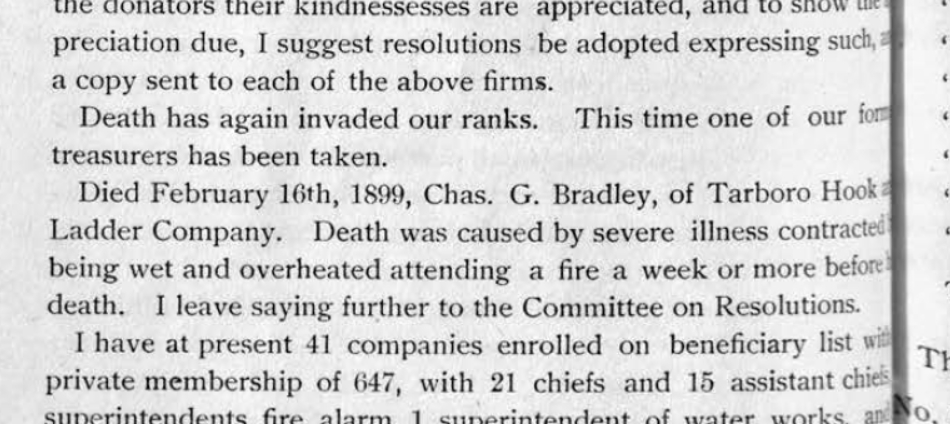
Here are totals for Raleigh Fire Departments unit runs and total calls last year…
Total Calls – 42,157
Total Runs – 62,033
E1 – 1,983
E2 – 1,830
E3 – 2,668
E4 – 1,249
E5 – 1,305
E6 – 882
Sq7 – 2,400
E8 – 2,070
E9 – 1,834
E10 – 1,689
E11 – 2,735
E12 – 2,622
E13 – 1,431
Sq14 – 1,600
E15 – 2,539
E16 – 1,963
E17 – 1,345
E18 – 1,178
E19 – 2,556
E20 – 1,713
E21 – 1,699
E22 – 1,478
E23 – 831
E24 – 927
E25 – 940
E26 – 1,058
E27 – 796
E28 – 794
E29 – 343
Special – Hurricane Matthew
E106 – 8
E110 – 11
E118 – 9
E129 – 3
L1 – 952
L2 – 2,041
L3 – 1,147
L4 – 2,300
L5 – 1,106
L6 – 417
L7 – 1,076
L8 – 1,007
L9 – 272
R1 – 1,281
B1 – 542
B2 – 664
B3 – 544
B4 – 325
B5 – 853
C20 – 141 (Platoon Division Chief)
Car 401 – 15 (Chief Fire Investigator, special called)
Car 402 – 188 (Fire Investigator)
Air 1 – 91
Air 2 – 89
HM1 – 83 (haz-mat)
HM2 – 101
HM3 – 77
HM4 – 41
HM5 – 84
MP1 – 25 (mini-pumpers)
MP2 – 12
MP3 – 10
USAR 801 – 25 (swift water rescue)
Busiest Engines
E11 – 2,735
E3 – 2,668
E12 – 2,622
E19 – 2,556
E15 – 2,539
Sq7 – 2,400
E8 – 2,070
E1 – 1,983
E16 – 1,963
E9 – 1,834
Busiest Ladders
L4 – 2,300
L2 – 2,041
L3 – 1,147
Busiest Battalion Chief
B5 – 853
Busiest Rescue (ha)
R1 – 1,281
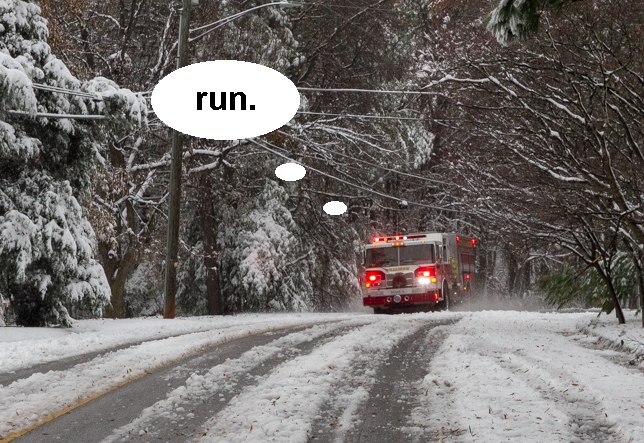
Found this this weekend. Vintage photo of Greensboro’s South Side Hose Company in 1899. They were the winners annual state firemen’s tournament Championship Reel Race. The winning times were:
Salisbury Hose Co. competed, was was ruled out. Eagle Hose Co. No. 7 of Greensboro withdrew, in favor of South Side.
The winning team was awarded the championship belt, to hold and display until the next year’s tournament. They also won $125 prize. The second place team won $75.
The contest consisted of members pulling a hand hose reel, running (pulling) and laying hose from a fire hydrant, connecting the hose to the hydrant, removing the other end of the hose from the reel, attaching a nozzle to the hose, and flowing water in the fastest time possible.
Distance they ran? Either 50 or 150 yards, based on the race. Can’t quite tell which one.
Pictured in the proceedings of that year’s North Carolina State Firemen’s Convention annual convention and tournament, bound copies of which are cataloged at Wilson Library at the University of North Carolina.
On March 5, 1945, the Charlotte Fire Department assisted with the “greatest mass transfer of polio patients in history”.
Led by Fire Chief W. Hendrix Palmer, the fire department helped the Charlotte Variety Club move 88 patients from the emergency polio hospital in Hickory to the new polio unit at Charlotte Memorial Hospital.
Travelling the 75-mile distance was a caravan consisting of fifteen ambulances, 74 automobiles, and “a number of trucks.” The vehicles traveled at 30 miles an hour and were escorted by members of CFD, police from Charlotte and Hickory, and the State Highway Patrol.
In Hickory, Chief Palmer carried the “first little polio patient” to the caravan and placed her on the ambulance. He also led the procession.
The mass transfer was sponsored by the Charlotte Variety Club, a “motion picture and showmen’s organization,” with Chief Palmer, Charlotte Police Chief Walter Anderson, and Mecklenberg County Police Chief Henry C. Severs assisting.
The story was recounted by North Carolina State Firemen’s Association Statistician Albert Brinson, in his annual report to members, which was included in a booklet with other business reports, but no conference proceedings, as the 1945 convention was “cancelled due to war conditions.” However, he cited 1944 as the year, instead of 1945.
The story was also covered in local newspapers and by wire services, such as a UP stories printed in the Rocky Mount Telegram on August 5 and August 6, 1945. See below. They added a few details, including Rock Hill Variety Club as the named sponsor, and noting that ten Charlotte firemen would help with moving the children. They were “especially trained to assist in any emergencies.”
The UP stories adds that forty-eight nurses would be assisting, and that the “mile-long” caravan would include two trucks, ten state highway patrolmen, four Charlotte motorcycle officers, and four county police units. They also noted the distance as 60 miles.
The patients ranged from 10 months to 29 years in age.
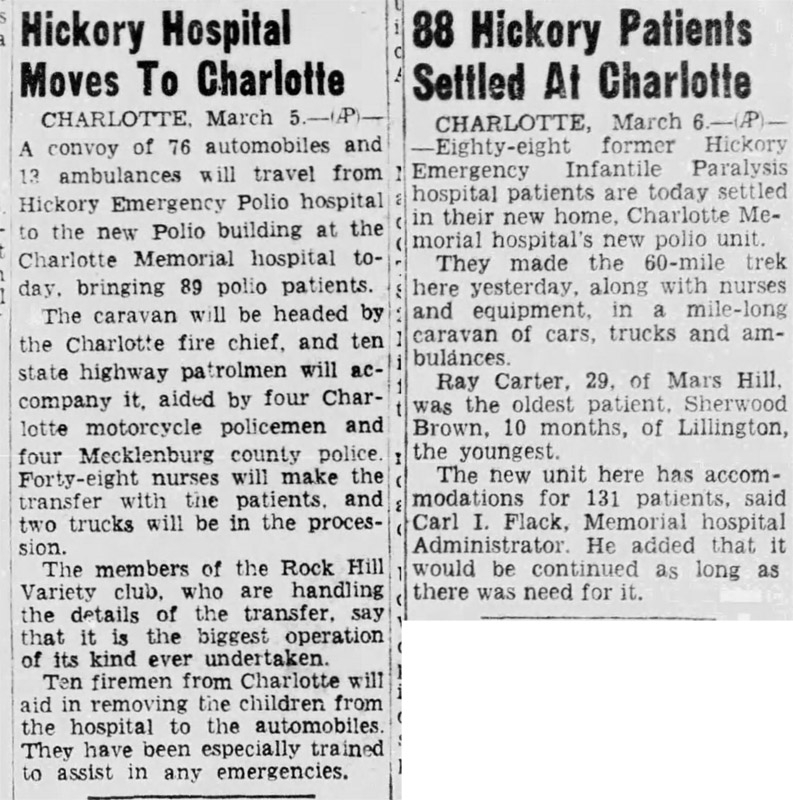 Rocky Mount Telegram, August 5, 6, 1945
Rocky Mount Telegram, August 5, 6, 1945